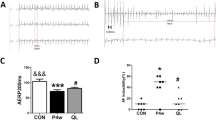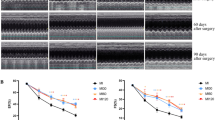Summary
The traditional Chinese medicine Shensong Yangxin (SSYX) can improve the clinical symptoms of arrhythmia in an integrated manner. This study aimed to investigate the electrophysiological effect of SSYX on the hearts of myocardial-infarcted rabbits and further explore the mechanism by which SSYX alleviates myocardial fibrosis. Myocardial infarction (MI) was established in rabbits by ligation of the left circumflex coronary. The rabbits were treated with SSYX (0.5 g/kg/d) or saline for 8 weeks by oral administration. Microelectrode array (MEA) technology was used in vivo for extracellular electrophysiological recordings of the infarct border zone. Masson’s trichrome staining was used to observe myocardial fibrosis. Western blotting was performed to evaluate the protein expression levels of collagen I (COL I) and collagen III (COL III). Quantitative real-time polymerase chain reaction (real-time PCR) was performed to evaluate the TGF-β1 and MMP-2 mRNA expression levels. The results showed that the total activation time (TAT) and the dispersion of TAT were significantly increased and the excitation propagation markedly disordered after MI. SSYX could significantly decrease TAT and the dispersion of TAT, and significantly ameliorate the chaotic spread pattern of excitation. Furthermore, SSYX treatment could significantly decrease COL I and COL III protein levels and down-regulate TGF-β1 and MMP-2 mRNA expression levels in MI rabbits. It was concluded that SSYX may ameliorate cardiac electrophysiological abnormalities in infarcted hearts by decreasing the protein levels of COL I and COL III, down-regulating the mRNA expression levels of TGF-β1 and MMP2, and thereby reducing adverse cardiac remodeling.
Similar content being viewed by others
References
Yu PJ, Cassiere HA, Kohn N, et al. Myocardial infarction classification on outcomes in nonemergent coronary artery bypass grafting. Ann Thorac Surg, 2015,100(5):1588–1593
Hayashi M, Shimizu W, Albert C M. The spectrum of epidemiology underlying sudden cardiac death. Circ Res, 2015,116(12):1887–1906
Burchfield JS, Xie M, Hill JA. Pathological ventricular remodeling: mechanisms: part 1 of 2. Circulation, 2013,128(4):388–400
Ringenberg J, Deo M, Filgueiras-Rama D, et al. Effects of fibrosis morphology on reentrant ventricular tachycardia inducibility and simulation fidelity in patient-derived models. Clin Med Insights Cardiol, 2014,8(Suppl 1):1–13
Anderson ML, Peterson ED, Peng SA, et al. Differences in the profile, treatment, and prognosis of patients with cardiogenic shock by myocardial infarction classification: A report from NCDR. Circ Cardiovasc Qual Outcomes, 2013,6(6):708–715
Lu HR, Rohrbacher J, Vlaminckx E, et al. Predicting drug-induced slowing of conduction and pro-arrhythmia: identifying the 'bad' sodium current blockers. Br J Pharmacol, 2010,160(1):60–76
Borowicz KK, Banach M. Antiarrhythmic drugs and epilepsy. Pharmacol Rep, 2014,66(4):545–551
Wu Y. Construction of the vessel-collateral theory and its guidance for prevention and treatment of vasculopathy. Front Med, 2011,5(2):118–122
Liu M, Zhao S, Wang Y, et al. Identification of multiple constituents in Chinese medicinal prescription Shensong Yangxin capsule by ultra-fast liquid chromatography combined with quadrupole time-of-flight mass spectrometry. J Chromatogr Sci, 2015,53(2):240–252
Liu Y, Li N, Jia Z, et al. Chinese medicine Shensong Yangxin is effective for patients with bradycardia: results of a randomized, double-blind, placebo-controlled multicenter trial. Evid Based Complement Alternat Med, 2014,2014(1): 605 714–605 714
Zou JG, Zhang J, Jia ZH, et al. Evaluation of the traditional Chinese Medicine Shensong Yangxin capsule on treating premature ventricular contractions: a randomized, double-blind, controlled multicenter trial. Chin Med J (Engl), 2011,124(1):76–83
Fujita M, Morimoto Y, Ishihara M, et al. A new rabbit model of myocardial infarction without endotracheal intubation. J Surg Res, 2004,116(1):124–128
Dhein S, Manicone N, Muller A, et al. A new synthetic antiarrhythmic peptide reduces dispersion of epicardial activation recovery interval and diminishes alterations of epicardial activation patterns induced by regional ischemia. A mapping study. Naunyn Schmiedebergs Arch Pharmacol, 1994,350(2):174–184
Amino M, Yoshioka K, Tanabe T, et al. Heavy ion radiation up-regulates Cx43 and ameliorates arrhythmogenic substrates in hearts after myocardial infarction. Cardiovasc Res, 2006,72(3):412–421
Smaill BH, Zhao J, Trew ML. Three-dimensional impulse propagation in myocardium: arrhythmogenic mechanisms at the tissue level. Circ Res, 2013,112(5):834–848
Navarrete EG, Liang P, Lan F, et al. Screening drug-induced arrhythmia [corrected] using human induced pluripotent stem cell-derived cardiomyocytes and low-impedance microelectrode arrays. Circulation, 2013,128(11 Suppl 1):S3–S13
Kandel SM, Roth BJ. The mechanism of reflection type reentry: A simulation study. J Cardiovasc Electrophysiol, 2015,26(12):1370–1375
Mihic A, Cui Z, Wu J, et al. A Conductive polymer hydrogel supports cell electrical signaling and improves cardiac function after implantation into myocardial infarct. Circulation, 2015,132(8): 772–784
Majumder R, Nayak AR, Pandit R. Nonequilibrium arrhythmic states and transitions in a mathematical model for diffuse fibrosis in human cardiac tissue. PLoS One, 2012,7(10):e45040–e45040
Tschabrunn CM, Roujol S, Nezafat R, et al. A swine model of infarct-related reentrant ventricular tachycardia: Electroanatomic, magnetic resonance, and histopathological characterization. Heart Rhythm, 2016,13(1):262–273
Jenkins G. The role of proteases in transforming growth factor-beta activation. Int J Biochem Cell Biol, 2008, 40:1068–1078
Shen N, Li X, Zhou T, et al. Shensong Yangxin capsule prevents diabetic myocardial fibrosis by inhibiting TGF-beta1/Smad signaling. J Ethnopharmacol, 2014,157: 161–170
Shi T, Yao Z, Qin Z, et al. Identification of absorbed constituents and metabolites in rat plasma after oral administration of Shen-Song-Yang-Xin using ultra-performance liquid chromatography combined with quadrupole time-of-flight mass spectrometry. Biomed Chromatogr, 2015,29(9):1440–1452
Author information
Authors and Affiliations
Corresponding author
Additional information
This work was supported by the National Key Basic Research Development Program of China (“973” Program) (No. 2012CB518604).
Rights and permissions
About this article
Cite this article
Dang, S., Huang, CX., Wang, X. et al. Shensong Yangxin (SSYX) ameliorates disordered excitation transmission by suppressing cardiac collagen hyperplasia in rabbits with chronic myocardial infarction. J. Huazhong Univ. Sci. Technol. [Med. Sci.] 36, 162–167 (2016). https://doi.org/10.1007/s11596-016-1560-4
Received:
Revised:
Published:
Issue Date:
DOI: https://doi.org/10.1007/s11596-016-1560-4




